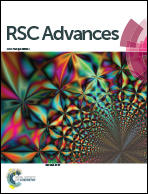Enhanced efficiency and high temperature stability of hybrid quantum dot light-emitting diodes using molybdenum oxide doped hole transport layer†
Abstract
High power efficiency (PE) and stability of quantum dot (QD) light-emitting diodes (QLEDs) are important factors for practical use in various displays. However, hybrid QLEDs consisting of an organic hole transport layer (HTL) and an inorganic electron transport layer (ETL) sometimes have poor stability due to the low thermal stability of the organic HTL. To solve the problem, here, we report enhanced efficiency, lifetime, and temperature stability in inverted and hybrid structured QLEDs by adopting a MoO3-doped HTL. Also, to improve the electron–hole charge carrier balance, a thin insulating interlayer was used between QDs and the ETL. As a result, the QLED with the p-doped HTL exhibited the increased PE by ∼28% and longer lifetime compared to the pristine QLEDs. In addition, the QLED showed stable operation at the high temperature up to 400 K, whereas the control device failed to operate at 375 K. We systematically investigated the effect of the MoO3-doping on the performance and thermal stability of the QLEDs. We believe that QLEDs with the p-doped HTL can be used for further QLED researches to simultaneously improve the efficiency, lifetime, and high temperature stability, which are highly required for their use in automotive and outdoor displays.



 Please wait while we load your content...
Please wait while we load your content...